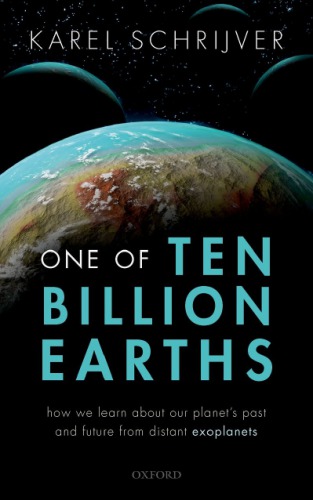(Ebook) One of Ten Billion Earths : How We Learn about Our Planet's Past and Future from Distant Exoplanets by Karel Schrijver ISBN 9780198799894, 0198799896
4. Exoplanet systems and their stars (The diversity of worlds ; Recognizing biases and the patterns in exosystems ; Detecting exoplanets ; A most unlikely place ; A most unlikely place, again ; Observing transits ; Attributes of exoplanets and exoplanetary systems ; Multiple suns ; Patterns in orbits of exosystems ; Characterizing planetary systems in general ; Surprises, composure, the sales pitch, and enthusiasm) -- 5. The birth of stars and planets (The dawn of the beginning ; Bold ideas ; The makings of planets and stars ; Nuclear power and the ingredients of apple pie ; Veiled nurseries ; Population studies and polychromatic imaging ; Team science ; Genesis of a star and its entourage ; Some not-quite stars among the genuine ones ; Assembling elements ; Distance markers ; Born together, different lives ; Ancient worlds ; Processes of formation ; Orbit migration, the snow line, and time) -- 6. Drifting through a planetary system (Intuition in science ; The changing orbits of planets ; The problem with Mars ; Resonant clocks and planetary orbits ; Testing the scenarios and Earth's water content ; Instabilities and bombardments ; Characteristics of planetary systems);1. From one to astronomical (Galaxies, stars, planets and more ; The first cool-star exoplanet, in Florence ; Transformation and the principles of uniformity and mediocrity ; Planet detectives ; Familiar with unfamiliar worlds! ; Faraway suns ; Advancing astrophysics ; Tools of science ; Anonymous renown ; Competitors in a team effort ; Narrowing in on the Goldilocks zone) -- 2. One step sort of life (In a planetary system, far, far away ; 'Don't you ever wonder where everybody is?' ; Looking for life ; The Drake and Rare Earth equations ; The communication challenge ; Is disequilibrium a signature of life? ; Where to start?) -- 3. Exploring the Solar system (Where did it all end up? ; How far to the Sun? ; A manifest of mass ; The composition of major and minor planets ; Expeditions to the neighbors ; Synchronizing the Moon ; Voyagers, explorers rovers and probes ; Sounding earth ; The stories of impacts ; The tales of comets ; Water in the Solar system ; Spinning and orbiting ; Patterns in orbits within the Solar system ; The active Sun ; Characteristics of our Solar system);Illustrated with images of the Solar System and of the Universe around it, this book explores how the discoveries within the Solar System and of exoplanets far beyond it come together to help us understand the habitability of Earth, and how these findings guide the search for exoplanets that could support life. The author highlights how, within two decades of the discovery of the first planets outside the Solar System in the 1990s, scientists concluded that planets are so common that most stars are orbited by them. The lives of exoplanets and their stars, as of our Solar System and its Sun, are inextricably interwoven. Stars are the seeds around which planets form, and they provide light and warmth for as long as they shine. At the end of their lives, stars expel massive amounts of newly forged elements into deep space, and that ejected material is incorporated into subsequent generations of planets.;10. Habitability of planets and moons (First stop: Titan ; Ancient life! Future life! ; Second stop: Venus ; Third stop: Mars ; Magnetism and lost oceans; Fourth stop: GJ581d, unconfirmed ; The challenge of exoplanet climatology) -- 11. The long view of planetary systems (Population of ecosystems ; The life-cycle of a planetary system ; How will it all end?) -- 12. Living on a pale blue dot (Interdisciplinary discipline ; Habitability, photosynthesis and volcanism ; Bringing it home ; Tipping points ; Snowball Earth ; Same Earth, different Earth ; The climate of life ; How does our Solar system compare? ; Earth: common and exceptional ; The prolonged transience of our yin-yang home);7. Lone rovers (A nearby supernova? ; Signatures of a primeval explosion ; Ancient meteorites ; Discoveries from the Lunatic Asylum ; The disintegration of the nursery ; The effects of stellar neighbors ; Exoplanets floating between the stars ; Thrown out of the system ; What is it like on a nomad planet?) -- 8. Aged stars and disrupted exosystems (The tool of light ; The contamination of white dwarfs ; The composition of shredded planets ; How can exoplanet remains fall into a white dwarf ; A preview of the future ; The rings of white dwarfs) -- 9. The worlds of exoplanets (The environment on exoplanets ; Visualizing the landscape ; The assortment of worlds ; Constraining exoplanet interiors ; Internal structure and history of formation ; The diversity of worlds, revisited)
*Free conversion of into popular formats such as PDF, DOCX, DOC, AZW, EPUB, and MOBI after payment.


